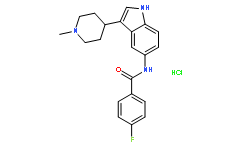| Cas No.: | 182563-08-2 |
| Chemical Name: | 4-fluoro-N-[3-(1-methyl-4-piperidinyl)-1H-indol-5-yl]-Benzamide |
| SMILES: | FC1=CC=C(C=C1)C(=O)NC2C=C3C(=CNC3=CC=2)C4CCN(C)CC4 |
| Formula: | C21H22N3OF |
| M.Wt: | 351.41728 |
| Purity: | >98% |
| Sotrage: | 2 years -20°C Powder, 2 weeks 4°C in DMSO, 6 months -80°C in DMSO |
| Description: | LY334370 is a selective 5-HT1F receptor agonist with a Ki of 1.6 nM. |
| Target: | Ki: 1.6 nM (5-HT1F) |
| In Vivo: | Following intravenous administration of LY334370 at 3 mg/kg (n=3) or 10 mg/kg (n=6) electrical stimulation evokes an increase in dural blood vessel diameter of 135±6% and 106±11%, respectively, which is not significantly different from the respective control values. LY334370 has no effect on dural blood vessel diameter per se, since the actualdural blood vessel diameter is 43±4 arbitrary units before drug and 43±4 arbitrary units 15 min after injection of LY334370 (10 mg/kg)[1]. |
| In Vitro: | LY334370 has no vasoconstrictor effects on human cerebral arteries in vitro until a dose of 10-5 M, at which it produces a contraction of 8.5±5.7%; however, this is not significant[1]. |
| Cell Assay: | Human cerebral artery is used in this study. Segments are prepared as previously described, but briefly they are placed in a buffer solution containing (mM) NaCl 119, NaHCo3 15, KCl 4.6, CaCl2 1.5, NaH2PO4 1.2, MgCl2 1.2, and glucose 5.5. Sections of vessel about 0.5 mm in diameter and 1 to 2 mm in length are mounted in a temperature-controlled tissue bath (37°C) containing buffer solution bubbled with 95% O2 and 5% CO2. The vessel segments are given a tension of 4 mN and allowed to stabilize at this tension for 1 to 1.5 h. Vessel reactivity is tested by exposure to 60 mM KCl. This is done twice for each segment and only if the response is similar to the segment used for LY334370 testing. Responses to LY334370 is calculated as a percentage of the maximum KC1 response[1]. |
| References: | [1]. Shepheard S, et al. Possible antimigraine mechanisms of action of the 5HT1F receptor agonist LY334370. Cephalalgia. 1999 Dec;19(10):851-8. |

 DC Chemicals' products qualify for U.S. tariff exemptions. We guarantee no price increases due to customs duties and maintain stable supply, continuing to deliver reliable research solutions to our American clients.
DC Chemicals' products qualify for U.S. tariff exemptions. We guarantee no price increases due to customs duties and maintain stable supply, continuing to deliver reliable research solutions to our American clients.





















